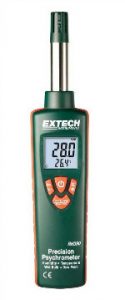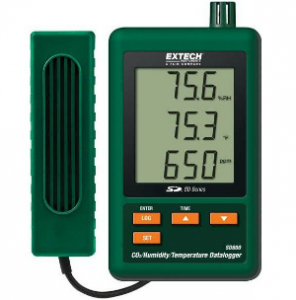Assessing Indoor Air Quality
Indoor Air Quality Assessment Isolates, Alleviates Worker Health Concerns
Assessing Indoor Air Quality (IAQ) is important, not only for keeping your workers comfortable during office hours, but also for keeping them healthy. Poor IAQ can be linked to headaches, fatigue, asthma, and other nose and throat problems.
Factors like improper ventilation, inability to properly control temperature, high or low humidity, certain building materials, water damage and mold, and HVAC filter contamination can contribute to poor IAQ. Performing a detailed IAQ assessment includes a thorough investigation and measurement of air quality pollutant sources, starting with air sampling.
There are many possible pollutants that could be responsible for poor indoor air quality, including these common concerns:
Laying the groundwork for the assessment by taking quality air sampling measurements of each of these possible pollutants is necessary to establish baseline conditions, compare indoor with outdoor air quality and test your hypothesis about the source of the problem.
Air samples should be collected from an adequate number of sites during an investigation to assess all likely sources of pollutants and their potential exposure to occupants in various locations in and around the office building. The locations may include individual HVAC zones – interior and perimeter, areas that have received worker complaints and those that have not, and those sites near smoking areas and printing shops.
Quality and accurate air sampling can also depend on changing weather conditions and seasonal differences. If your HVAC system uses an economizer to reduce energy consumption, it reduces the outdoor air supply which could skew the results of the sampling. To ensure you are getting accurate, qualitative sampling results, verify that your measuring devices are operating properly and recently calibrated.
The portability and effectiveness of products in today’s market make measuring IAQ more accessible and easier for both the seasoned health and safety official and the non-specialist property manager alike. Instrumentation is divided into three categories, a sampler, an analyzer and a direct-reading device, and the type of device you use depends on the type of pollutant you want to measure.
Temperature and Humidity
Nothing can affect productivity or comfort in the workplace like extreme temperatures – either it’s too cold or it’s too warm. The ideal thermal comfort zone is when the air temperature, humidity level, and air movement are within a specified range, when at least 80 percent of workers are comfortable, according to both the CAN/CSA Z412-00 (R2005) and the ASHRAE Standard 55-1992. Low humidity (below 25 percent) can also cause discomfort like stuffy noses, chapped lips, and dry skin, not to mention static electricity. High humidity levels cause condensation and an airless and oppressive office space which encourages the growth of mold and other fungi. Acceptable ranges for humidity in office buildings to maintain the thermal comfort zone is between 30 and 60 percent. Seasonal changes in air flow also affect humidity levels switching from humidifiers in the winter and dehumidifiers in the spring and summer months.
Prior to air sampling, double-check that thermostats and humidifiers are functioning properly and take note if heaters or other heat-producing equipment have been added or if anyone is using a fan that could cause temperature fluctuations. Also determine if there are uninsulated floors, cold or hat window frames, thermal gradients, obstructions to air flow, or signs of condensation.
While there are several ways to measure temperature and relative humidity – from simple thermometers to elaborate electronic equipment – psychrometers and hygrometers are effective methods for air sampling. A psychrometer uses the difference in readings between 2 thermometers, one having a dry bulb and the other a wet bulb, in order to measure the relative humidity of air or moisture content. Similarly, a hygrometer measures the moisture content in the environment using a sensor that changes its resistance as the humidity varies. A hygrometer proves useful for spot measurement or continuous humidity logging. When measuring temperature and humidity, it is recommended that you avoid sites near machinery or areas heated by the sun or other radiation sources.
Carbon Dioxide
Reports of headaches, fatigue, and eye and throat irritation in the office could be a sign that indoor carbon dioxide levels are high. Carbon dioxide is a colorless, odorless gas that is naturally present in the atmosphere at levels of approximately 300 to 400 ppm, and is a normal element of breath that’s exhaled and is frequently measured as a tool for screening in order to assess whether adequate volumes of fresh outdoor air are being introduced into indoor air. The carbon dioxide level is usually greater inside a building than outside, even in buildings with few complaints about indoor air quality. A typical Indoor carbon dioxide level is 800 ppm, so if the level reaches 1000 ppm it could indicate the office building has inadequate ventilation. When taking carbon dioxide air samples, remember that levels are normally at their highest in the morning and late afternoon.
Before measuring and comparing carbon dioxide levels inside the office building, you’ll want to determine if there are newly renovated or closed spaces without thermostats or recently renovated spaces that are not longer being used for their original purpose. You also want to ensure controls, dampers, diffusers, and exhaust outlets are not blocked and operating properly.
The best ways to collect air samples for inside carbon dioxide are to use either a direct-reading colorimetric tube or an infrared analyzer. A direct-reading colorimetric tube uses a hand pump to draw air through a glass tube packed with a specific compound. Direct-reading instruments are effective for spot checks or can be set up for continuous monitoring. Spot samples can provide a detailed profile of carbon dioxide concentration over time. For effective measurement, the collector should stand away from the instrument to prevent contaminating the sample. Infrared analyzers, also a direct-reading instrument, measure traces of gas by determining the absorption of an emitted infrared light source through the air sample. The device is extremely portable and can be moved easily from one location to the next to instantly measure carbon dioxide levels.
Air Motion
Outdoor air quality and how it’s delivered indoors, including the breathing zones of occupants, are critical to maintaining good IAQ. Mechanical ventilation systems in large office buildings are designed and operated not only to heat and cool the air, but also to draw in and circulate outdoor air. If they are poorly designed or operated causing inadequate air motion inside the building or if vents are blocked or ineffectively placed, air can’t reach the breathing zone of the occupants, resulting in poor ventilation.
When taking air samples to check air motion you’ll want to first determine if recent renovations have been made and if the ductwork, diffusers, filters, and return grilles are functioning properly and there are no blockages. Also, ensure dampers and exhaust and diffuser ducts are properly placed.
Measure air motion in ventilation ducts and inside the office using one of these effective devices – a smoke tube, a thermal anemometer , or a thermal comfort meter. A smoke tube easily tracks the motion of the contaminant by producing a visible aerosol plume when it comes in contact with humidity and propels the smoke into the air, making the current visible. Thermal anemometers use a heated probe element that’s inserted into the airstream. Air speed can then be inferred from the heating power necessary to maintain the probe at a temperature elevation. Thermal comfort meters measure mean radiant temperature, air temperature, humidity, and air motion to produce a “level of comfort”.
Carbon Monoxide
Nausea, dizziness, and disorientation at the workplace. Could be symptoms of the flu, or it could be something more serious like carbon monoxide poisoning. Carbon Monoxide is a toxic, colorless, and odorless gas that’s impossible to smell, taste, or see and is extremely toxic. The Carbon Monoxide exposure effects can greatly vary from person to person depending on health level, age, and the length of exposure. In an office building, carbon monoxide sources can include tobacco smoke, automobile exhaust from attached garages, leaking furnaces and gasoline powered equipment, to name a few.
ASHRAE Standard 62-1989 specifies an 8-hour average exposure limit for Carbon Monoxide that should not exceed 9 ppm. However, levels above 5 ppm indicate an adverse presence of combustion pollutants – once located, they should be exhausted.
Before taking air samples to measure Carbon Monoxide levels, inspect machine shops, parking garages, loading docks, etc. to ensure they are properly ventilated and determine if there are access routes or pathways that the exhaust and fumes are traveling. Make sure there are no vehicles running at the time of sampling and check for possible sources near entrances and exits. If you have Carbon Monoxide sensors test they are properly operating. In addition to the attached areas, inspect the inside of the offices thoroughly for possible sources like stoves and heaters and the locations of offices and air intakes.
Three instruments you can use to measure carbon monoxide levels are a direct-reading tube, an electrochemical analyzer, or infrared monitoring. As previously discussed, direct-reading tubes are a low-cost form of measuring for spot-sampling that uses a hand pump to draw air through a glass tube. Electrochemical analyzers sample air through a small pump that oxidizes carbon monoxide to carbon dioxide and generates a quick and accurate reading. Infrared monitors are also direct-reading instruments that sense the characteristic properties of the gas and generates an electrical signal output according to the difference in absorption between a sample cell and a reference.
Source by: Dan Martin, Territory Sales Manager – REED Instruments




